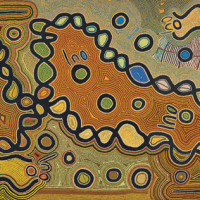43. JUDY WATSON NAPANGARDI Women’s Dreaming 1995

Judy Watson Napangardi is a Warlpiri artist who was born at Yarungkanji on Mt. Doreen Station, a cattle station northwest of Alice Springs. Warlpiri country is located in the Tanami Desert, and this is where Judy spent most of her life, embracing the traditional nomadic lifestyle of the Warlpiri people, travelling on foot throughout the land, hunting and collecting bush tucker. She spent extended periods in Mina Mina and Yingipurlangu, both significant ancestral and cultural sites in Warlpiri country that are represented repeatedly throughout her oeuvre.
Mina Mina, located near Lake McKay in the Tanami Desert, is a major womens ceremonial site where according to Womens Dreaming Warlpiri ancestors collected ceremonial digging sticks, known as kana orkarlangu, that had emerged from the ground. The women then used these kana orkarlangu in song and dance rituals as they journeyed across their country. Many of Judys artworks depict Mina Mina and elaborate on these Dreamings associated with this sacred place, including the present work. In Womens Dreaming key elements of this story such as the women themselves, the digging sticks, and the sacred sites are represented by U, O and I shapes. The depictions of these three symbols together indicate where the women stopped at significant sites along their journey and performed ceremonies and dances.
Judy was taught painting by her elder sister Maggie Napangardi Watson (1921-2004) and from 1986 began creating work as part of the Warlurkurlangu Artists Aboriginal Association. Together the two sisters developed a unique style of painting that was characterised by coloured sinuous lines created using a 'dragged' dotting style. These lines are said to imitate the ceremonial dances of their female ancestors as they moved across the desert in long lines. As seen in Womens Dreaming, by intersecting all areas of the canvas with these twisting contours Judy evokes the life and movement of her ancestors traveling and dancing across the land. The splendidly rich design mimics the complex stories of Womens Dreaming that Judy had passed down to her via stories, songs and dances throughout her life, and which she reveals to us here through the medium of painting. The energy and richness apparent in this painting are also reflective of Judy herself. By all accounts she was a remarkable woman who, despite her small stature, lived a life of prodigious energy, mothering ten children and producing a dynamic body of artwork.
Womens Dreaming is an important example of Judys later, more boldly coloured works. Access to synthetic paints enabled her to employ a broader range of more vibrant colours, with many of her works using hot pink, purple, lime green, bright yellow, and aqua, as we can see here. As noted by writer and curator, Christine Nicholls, often to the western eye a desert seems uniformly monochrome and lifeless, but to Judy and the Warlpiri people a desert is perceived as a large and colourful garden, bursting with energy1 In choosing bold colours Judy is celebrating the abundance of her peoples homelands as well as the sophisticated spiritual narrative imbued within them. Thus, her work is ripe with both actual depictions of the land itself and metaphorical depictions of Womens Dreaming.
Judy's work has been exhibited internationally in Europe, the United States of America, and Japan, most significantly in the group exhibitions Chicago International New Art Forms Exposition in Chicago, 1993 and Echoes of the Dreamtime in Osaka, 1994. In 2004 her work was included in the important exhibition Colour Power-Aboriginal Art Post 1984 at the National Gallery of Victoria. Her work is well represented in Australian public collections, including that of the National Gallery of Australia, the National Gallery of Victoria and the Art Gallery of New South Wales.
Footnotes
1. Nicholls, C., 'The Three Napangardis, To the Memory of Maggie Napangardi Watson in Judith Ryan, ed., Colour Power-Aboriginal Art Post 1984 in the Collection of the National Gallery of Victoria, Melbourne, National Gallery of Victoria, 2004, p.124
Asta Cameron BA, MA (Art Curatorship)